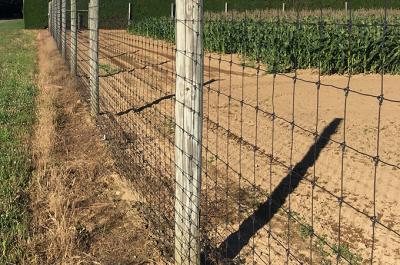Sagaponack to Hold Deer Fence Hearing

The Sagaponack Village Board will hold a public hearing on Nov. 13 on proposed deer fence regulations. The current code states that permits to install eight-foot-high deer fences are allowed only for properties in agriculture production. The proposed legislation defines agricultural production to mean a commercial enterprise. The change would allow the board to grant fence permits to bona fide farmers who want to protect cash crops, while denying permits to homeowners who want to grow fruits and vegetables.
“We’re not trying to get into a fight with anybody, we just clarified what we need to evaluate proposals,” Mayor Donald Louchheim said on Friday.
The murkiness of the village code became apparent after a July 9 board meeting at which two people, one who owns property on Parsonage Lane, the other on Bridge Lane, applied for permits to build high fences. Parsonage Lane neighbors vehemently opposed fencing and questioned whether the property owners could legitimately claim to be farmers.
After months of adjourning hearings on the applications, the board enacted a 90-day moratorium on deer fencing in September while it worked on rewriting the code. The legislation now under consideration, Mayor Louchheim said, is largely based on the state’s Agriculture and Markets Law. “We did a very thorough job and took into consideration criticisms from neighboring property owners and the needs of legitimate farmers,” Mr. Louchheim said. “I’d like to think we touched all the bases.”
The proposed law requires applicants to demonstrate an economic loss would occur without fencing, that other types and heights of fencing had been investigated, and that the installation would be done in a manner to protect the “visual and scenic resources of the village.” A survey showing the location of the fence and any encroachments on contiguous properties would have to be submitted.
The law, said the mayor, was crafted to provide leeway for the creation of new farms. “One of our missions is to encourage more agricultural use of the open space that’s been preserved here.” If the law is passed, Mr. Louchheim predicted that the two applicants now before the board would receive permission to install some deer fencing, though likely not the full amount they are seeking.
If the proposed law were adopted, an application for a fence from the owner of a start-up farm would be evaluated on such criteria as the amount of capital investment in the business, the business plan, the acreage in production, the applicant’s experience and direct participation, and the property’s two-year history of crop production. One provision that would apply to both established and new farms is that any fence on agricultural land that remains fallow for two years would be subject to removal at the owner’s expense.
At the public hearing, the mayor expects to hear a wide range of views. “We have extremists on both ends. People who want no deer fencing, and people who think, ‘It’s my property and I can do whatever I goddamn please.’ ”
